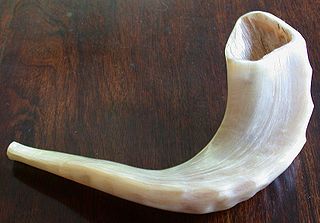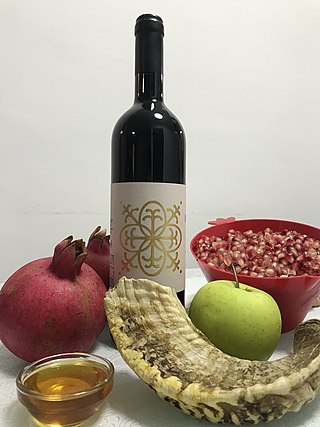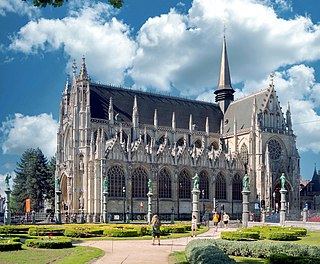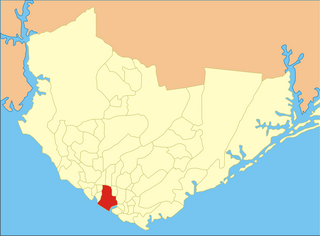
The machzor is the prayer book which is used by Jews on the High Holy Days of Rosh Hashanah and Yom Kippur. Many Jews also make use of specialized machzorim on the three pilgrimage festivals of Passover, Shavuot, and Sukkot. The machzor is a specialized form of the siddur, which is generally intended for use in weekday and Shabbat services.
Julius Edwin Harlow was an American Conservative rabbi and liturgist.

Humanistic Judaism is a Jewish movement that offers a nontheistic alternative to contemporary branches of Judaism. It defines Judaism as the cultural and historical experience of the Jewish people rather than a religion, and encourages Jews who are humanistic and secular to celebrate their identity by participating in relevant holidays and rites of passage with inspirational ceremonies that go beyond traditional literature while still drawing upon it.

In Judaism, the High Holy Days, also known as High Holidays or Days of Awe consist of:
- strictly, the holidays of Rosh Hashanah and Yom Kippur ;
- by extension, the period of ten days including those holidays, known also as the Ten Days of Repentance ; or,
- by a further extension, the entire 40-day penitential period in the Jewish year from Rosh Chodesh Elul to Yom Kippur, traditionally taken to represent the forty days Moses spent on Mount Sinai before coming down with the second ("replacement") set of the Tablets of Stone.

Tashlikh or Tashlich is a customary Jewish atonement ritual performed during the High Holy Days on Rosh Hashanah. In some Judaeo-Spanish-speaking communities the practice is referred to as sakudirse las faldas or simply as faldas.
The Union of Orthodox Rabbis of the United States and Canada (UOR), often called by its Hebrew name, Agudath Harabonim or (in Ashkenazi Hebrew) Agudas Harabonim ("union of rabbis"), was established in 1901 in the United States and is the oldest organization of Orthodox rabbis in the United States. It had been for many years the principal group for such rabbis, though in recent years it has lost much of its former membership and influence.
Mussaf is an additional service that is recited on Shabbat, Yom Tov, Chol Hamoed, and Rosh Chodesh. The service, which is traditionally combined with the Shacharit in synagogues, is considered to be additional to the regular services of Shacharit, Mincha, and Maariv. In contemporary Hebrew, the word may also signify a newspaper supplement.
Special Shabbatot are Jewish Shabbat days on which special events are commemorated. Variations in the liturgy and special customs differentiate them from the other Shabbats and each one is referred to by a special name. Many communities also add piyyutim on many of these special Shabbatot. Two such Shabbats, Shabbat Mevarchim—the Shabbat preceding a new Hebrew month—and Shabbat Rosh Chodesh can occur on several occasions throughout the year. The other special Shabbats occur on specific sabbaths before or coinciding with certain Jewish holidays during the year according to a fixed pattern.

Rykestrasse Synagogue, Germany's largest synagogue, is located in the Prenzlauer Berg neighbourhood in the Pankow borough of Berlin. Johann Hoeniger built the synagogue in 1903/1904. It was inaugurated on 4 September 1904, in time for the holidays of and around Rosh Hashanah. The synagogue stands off the street alignment and is reached by a thoroughfare in the pertaining front building.
Temple Beth Israel was a Jewish synagogue located at 840 Highland Road in Sharon, Pennsylvania, in the United States. Originally called House of Israel Congregation, it was founded in 1888 as an Orthodox congregation by Eastern European Jews. The congregation merged with Congregation Rodef Sholom of Youngstown, Ohio in July, 2013; and the former synagogue building was sold to a Christian church in 2014.

Rosh HaShanah is the New Year in Judaism. The biblical name for this holiday is Yom Teruah. It is the first of the High Holy Days, as specified by Leviticus 23:23–25, that occur in the late summer/early autumn of the Northern Hemisphere. Rosh Hashanah begins ten days of penitence culminating in Yom Kippur, as well as beginning the cycle of autumnal religious festivals running through Sukkot which end on Shemini Atzeret in Israel and Simchat Torah everywhere else.
Nusach Ashkenaz is a style of Jewish liturgy conducted by Ashkenazi Jews. It is primarily a way to order and include prayers, and differs from Nusach Sefard and Baladi-rite prayer, and still more from the Sephardic rite proper, in the placement and presence of certain prayers.

The Blackpool Reform Jewish Congregation is a Reform Jewish congregation and synagogue, located in Blackpool, Lancashire, England, in the United Kingdom.

The Sablon or Zavel is a neighbourhood and hill in the historic upper town of Brussels, Belgium. At its heart are twin squares: the larger Grand Sablon or Grote Zavel square in the north-west and the smaller Petit Sablon or Kleine Zavel square and garden in the south-east, divided by the Church of Our Blessed Lady of the Sablon. This area is served by Brussels-Chapel railway station and Brussels-Central railway station, as well as the tram stop Petit Sablon/Kleine Zavel.

The Jewish Museum of Belgium is a museum in central Brussels, Belgium, focusing on the history of the Jews in Belgium. It is located at 21, rue des Minimes/Minimenstraat in the Sablon/Zavel district of Brussels. This site is served by the bus stop Grand Sablon/Grote Zavel.

The Beit Yaacov/Rabi Meyr Synagogue is the current synagogue of the Jewish Community of Manaus, Amazonas, Brazil. Founded in 1962, this Traditional Judaism congregation is one of the largest and most influential synagogues of Amazonian Jews in the Northern Brazil. The Jewish Labour Zionist youth movement Habonim Dror is established in Manaus and it is part of the Community. The construction was financed by the local entrepreneurs Isaac Benayon Sabbá, Samuel Benchimol, José Benzecry and Moysés Benarrós Israel. The synagogue is locally referred to as 'esnoga,' derived from the Ladino term for synagogue which is derived from the Hebrew words for fire (אש) and brightness (נוגה).

The blowing of the shofar is a ritual performed by Jews on Rosh Hashanah. The shofar is a musical horn, typically made of a ram's horn. Jewish law requires that the shofar be blown 30 times on each day of Rosh Hashanah, and by custom it is blown 100 or 101 times on each day.
Speak unto the children of Israel, saying: In the seventh month, in the first day of the month, shall be a solemn rest unto you, a memorial proclaimed with the blast of horns, a holy convocation.
The Great Park Synagogue is an Orthodox synagogue situated in Houghton, Johannesburg. The present building was consecrated in 2000, after the congregation vacated their long-time home, the Great Synagogue on Wolmarans Street, Hillbrow in 1994, after eighty years. The Wolmarans Street synagogue came to be known as the city's mother synagogue and "the crown jewel of Orthodox Judaism in South Africa." All large-scale Jewish events in Johannesburg were held in the building, and throughout its existence it was the seat of the country's chief rabbi. Northward migration by congregation members led to the synagogue closing its doors in 1994. The relocated synagogue was built on the model of the Great Synagogue, whose own architecture in turn was inspired by the Hagia Sophia. Great Park Synagogue was also the original name of the synagogue on Wolmarans Street before it became the Great Synagogue.

The synagogue on Fraenkelufer in Berlin's Kreuzberg district was built as an Orthodox Synagogue between 1913 and 1916 according to plans and under the direction of the master builder of the Jewish Community of Berlin, Alexander Beer. The structure was located on Kottbusser Ufer 48–50, today's Fraenkelufer 10-16. On Kristallnacht, the evening of November 9-10th, 1938, the main building of the synagogue was badly damaged. Further destruction in the following years led to the structures ultimate demolition in 1958/1959 after the end of World War II. Today the surviving outbuilding, previously used for the youth service, has been renovated and is home to a Conservative Synagogue. A complete reconstruction of the main synagogue that was destroyed by the Nazis is being planned for its original location.

The Synagogue of Anderlecht, officially the Synagogue of the Orthodox Jewish Community of Brussels, and also known as the Israelite Orthodox Synagogue of Cureghem, is an Orthodox Jewish synagogue, located in the heart of the former Jewish quarter of Cureghem/Kuregem, at 67A, rue de la Clinique/Kliniekstraat, in the municipality of Anderlecht, Brussels, Belgium. The synagogue is the main synagogue of the Israelite Orthodox Community of Brussels. It can be accessed from Clemenceau metro station on lines 2 and 6 of the Brussels Metro.














